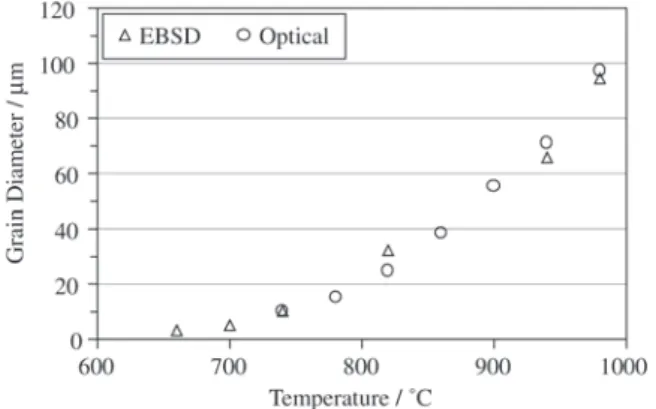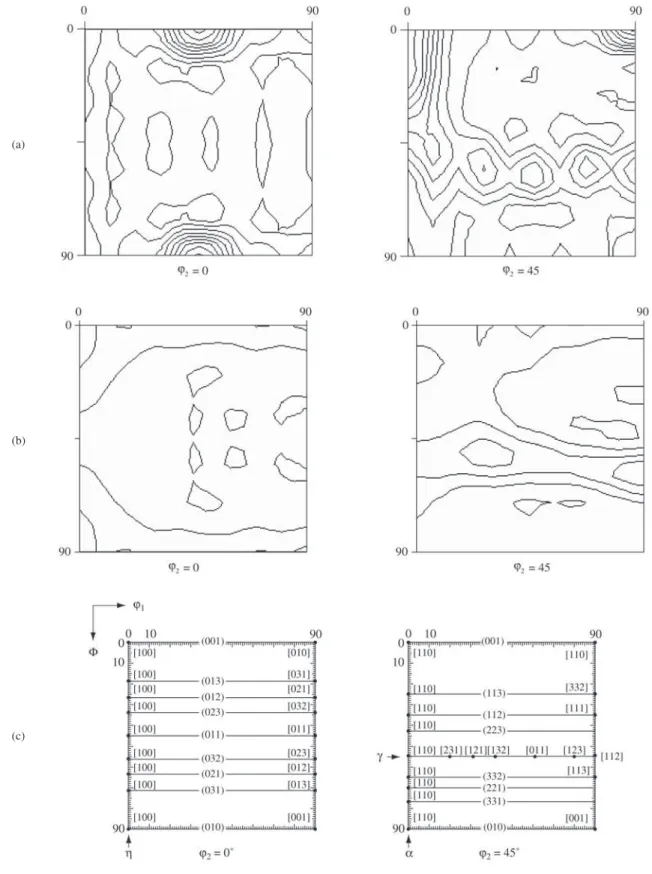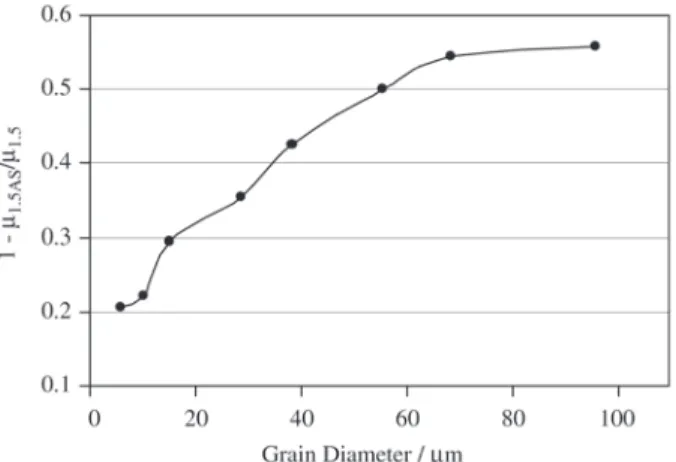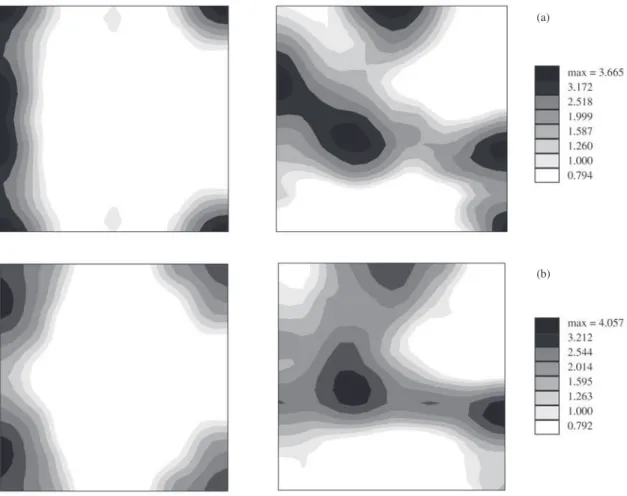*e-mail: scpaolinelli@acesita.ind.br
Effect of the Annealing Temperature on the
Structure and Magnetic Properties of 2% Si Steel
Marco A. da Cunha, Sebastião C. Paolinelli*
Acesita S.A. - Praça Primeiro de maio, 9, 35180-018 Timóteo - MG, Brazil
Received: September 27, 2001; Revised: July 10, 2002
To study the effect of the annealing temperature on the structure and magnetic properties of a 2%Si non-oriented steel cold rolled samples were submitted to final annealing in the temperature range of 540 °C to 980 °C in hydrogen atmosphere. The samples had received cold rolling reduc-tion of 75% to a final thickness of 0.50 mm. Recovery and recrystallizareduc-tion resulted in significant improvement of magnetic properties, with decrease of iron loss (W1.5) and increase of polarisation (J50) and relative permeability (µ1.5). On further grain growth, after recrystallization, there was
simultaneous decrease of iron loss, polarisation and relative permeability. Texture evolution on grain growth accounts for the observed decrease of J50 and µ1.5. The beneficial effect of increasing
grain size on core loss overcomes the detrimental effect of texture resulting in decrease of W1.5.
Keywords: silicon steel, magnetic properties, recrystallization, texture
1. Introduction
In many applications of non-oriented grain silicon steels low iron loss and high permeability are important require-ments. It is well known that the magnetic properties are determined by factors such as: composition of the steel, purity level, grain size, strain, crystallographic texture, sur-face oxidation. The polarisation measured at 5000 A/m (J50) is strongly dependent on crystallographic texture. The rela-tive permeability at 1.5 T (µ1.5) is strongly dependent on texture, but is also affected by cutting stress, grain size, sur-face oxidation and nitration. The grain size obtained in the final annealing is one of the most important factors deter-mining iron loss. To optimise the magnetic properties it is important to understand its evolution in the final annealing. The purpose of the present work was to investigate the evo-lution of the structure, texture and the magnetic properties in the final annealing.
2. Experimental Procedure
Cold rolled samples of a 2%Si steel 0.50 mm thick were used in this investigation. The samples were taken from in-dustrial production and had received cold rolling reduction of 75%. Final annealing was carried out in a continuous
annealing furnace, under hydrogen atmosphere, at tempera-tures in the range of 540 °C to 980 °C. The final structure was characterised by optical microscopy and the texture was analysed by X-ray diffraction, at an intermediate position between centre and surface, and by EBSD at a longitudinal section, across the whole thickness. Magnetic properties, iron loss at 1.5 T and 60 Hz (W1.5), polarisation J50 and rela-tive permeability µ1.5, were measured in the rolling direc-tion on as sheared samples 305 × 30 mm, using a single sheet tester.
3. Results
Structure and Texture
deformed grains remain, particularly in the centre region. Some non-uniformity in grain size distribution is observed at 700 °C due to the growth of recrystallized grains at the expenses of low Taylor factor deformed grains. At 740 °C recrystallization is complete and some further grain growth has occurred. The Average recrystallized grain size is shown in Fig. 2 as a function of the annealing temperature.
The textures measured for the samples annealed at 540 °C and 700 °C are shown in Figs. 3a and 3b. The tex-tures are represented in ODF sections of ϕ2 = 0° and ϕ2 = 45°, Bunge notation. A key to the position of the main orientations is shown in Fig. 3c. The initial texture, Fig. 3a, has compo-nents of the α fibre (direction [110] parallel to the rolling direction - RD) and γ fibre (direction [111] parallel to the normal direction – ND) with the highest intensities in orientations of the α fibre. Similar results on silicon steels
ture, and reduces the intensities along the η and α fibres.
Magnetic Properties
Figure 6 shows the magnetic properties as a function of the annealing temperature. The effect of the different stages of recovery, recrystallization and grain growth on the mag-netic properties can be clearly seen. Recovery, between 540 °C and 620 °C, results in a steady improvement of mag-netic properties. With recystallization there is a sharp de-crease of iron loss and inde-crease of J50 and µ1.5 between 620 °C and 740 °C. At this stage the deformation substructure is consumed and a more random texture is formed. Further grain growth results in decrease of iron loss and also de-crease of J50 and µ1.5. J50 is maximum at 740 °C and µ1.5 is maximum at 780 °C. The iron loss W1.5 is strongly affected by grain size, and so decreases with the annealing tempera-ture. Polarisation J50 is strongly dependent on texture and decreases with the strengthening of the γ fibre, being maxi-mum at the temperature of complete recrystallization. Around 900 °C it tends to increase again with the weaken-ing of the texture. The relative permeability µ1.5 shows maxi-mum at a slightly higher temperature than J50. This behav-iour has also been observed in other experiments, in which cutting stresses were absent, and has been attributed to a combined effect of grain size and texture. Increasing grain size has a beneficial effect on µ1.5 that might explain the shift in the maximum to a higher temperature. The detri-mental effect of cutting stresses on µ1.5 increases with the grain size, as shown in Fig. 7. It adds to the effect of strength-ening the γ fibre texture with temperature, contributing to decrease µ1.5 continuously.
4. Discussion
Texture Evolution on Recrystallization and Grain Growth
Samples annealed at 660 °C and 700 °C were analysed by EBSD and the orientation distributions of the recrystallized grains are shown in Figs. 8a to 8b. More than 1000 recrystallized grains were observed in each sample.
Figure 1. Typical microstructures for the sample annealed at 660 °C.
Figure 3.ϕ2 = 0° and ϕ2 = 45° ODF sections, Bunge notation, for the samples annealed at: a) 540 °C and b) 700 °C (levels: 0.08 -1.67 - 3.42 - 5.17 - 6.92 - 8.67 - 10.4 - 12.1 - 13.9 - 15.6 ); c) ϕ2 = 0° and ϕ2 = 45° sections of Euler space showing the main bcc texture components and fibres.
(a)
(b)
The orientation distributions were calculated by the bin-ning method with 5° resolution.
At 660 °C nucleation occurs mainly in the high Taylor factor γ fibre grains and the nuclei have a weak texture with high intensity peaks at (111)[112], (225)[110] (α fibre at
Φ = 30°) and along the η fibre (particularly between (110)[001] and (210)[001] and at (100)[001]). That explains the reduction in the volume fraction of γ fibre in the begin-ning of recrystallization in Fig. 5 4. It is known that nuclei with Goss orientation are formed mainly at in-grain shear bands in (111)[112] deformed grains5. For that reason the volume fraction ratio between (111)[112] and (111)[110],
shown in Fig. 5, also decreases with the beginning of recrystallization. The EBSD results, however, show that along the γ fibre there is preferential nucleation of (111)[112]. These results are consistent with previous stud-ies in low carbon and extra low carbon steels that relate (111)[112] nucleation with the presence of strong α fibre in the deformation texture3,6.
Further nucleation favours the high Taylor factor orientations and the η fibre. At 700 °C, at a more advanced stage of recrystallization, the γ fibre is well defined, with high intensity peak at (111)[112] and minor peak at (111)[110]. Along the η fibre the high intensity shifts to (410)[001]. At this temperature recrystallized grains have grown and partially consumed the low stored energy α
fi-Figure 7. Relative permeability (µ1.5 ) decrease due to cutting stress as a function of grain size. µ1.5AS is the permeability of samples annealed and cut afterwards in the dimensions 305 × 30 mm (as sheared); µ1.5 is the permeability of specimens previously cut in the dimensions of the test and then annealed.
Figure 6. Core loss (W1.5), polarisation (J50) and relative perme-ability (µ1.5) as a function of the annealing temperature.
Figure 5. Volume fractions of the main fibres (α, η, γ) and ratio between the volume fractions of (111)[112] and (111)[110] as a function of the annealing temperature. The volume fractions were calculated within 15° around the ideal orientations. The a fibre values plotted represent the volume fractions of α fibre (Φ = 0 to 90°) minus the volume fractions of (111)[110].
Figure 8.ϕ2 = 0° and ϕ2 = 45° ODF sections, Bunge notation, for recrystallized grains of specimens annealed at: a) 660 °C and b) 700 °C. Data obtained by EBSD; ODF calculated by the binning method with 5° resolution.
bre deformed grains, causing the volume fraction of the α
fibre in Fig. 5 to decrease significantly. The increase in vol-ume fraction of γ fibre above 660° results from further nu-cleation and growth. The volume fraction ratio between (111)[112] and (111)[110] increases significantly, as a con-sequence of preferential nucleation. At this stage there is no grain size advantage of (111)[112] over (111)[110] but the number of grains per square millimetre of (111)[112] is around 65% higher than that of (111)[110].
Further grain growth after recrystallization strengthens the texture and the γ fibre volume fraction continues to in-crease (particularly the volume fraction of (111)[112]) at the expenses of other orientations such as η and α fibre. The strengthening of the γ fibre on grain growth has been reported on low carbon steels 4 and attributed to the growth of larger grains consuming the smaller ones. In the present work, however, γ fibre grains, particularly (111)[112] grains, show no size advantage at 740 °C, when some normal grain growth seems to have already occured.
Magnetic Properties
The ideal combination of magnetic properties would re-quire increasing polarisation and permeability and decreas-ing iron loss with the annealdecreas-ing temperature. Grain growth after recystallization has a beneficial effect on core loss and
µ1.5. The recrystallization texture and its evolution on grain growth have an important effect on the magnetic proper-ties. The effect of an adverse evolution of texture on core loss has been shown to be overcome by the beneficial effect of increasing grain size. The effects of texture and cutting stress on µ1.5 are moresignificant and determine its behav-iour. B50 is known to be strongly dependent on texture and after recrystallization is controlled by texture evolution. In another recent paper the authors have shown that beneficial texture evolution after recrystallization can be obtained by two stages of cold rolling with an intermediate annealing, resulting in reduction of core loss and simultaneous increase of B50 and µ1.57.
(a)
The authors gratefully acknowledge the assistance of T.R. Oliveira and P.E.F. Cortes.
7. Cunha, M.A.; Paolinelli, S.C. 15th Soft Magnetic



